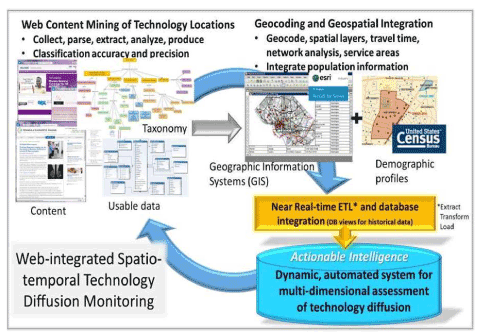Difference between revisions of "Template:Article of the week"
Shawndouglas (talk | contribs) (Updated article of the week text.) |
Shawndouglas (talk | contribs) (Updated article of the week text.) |
||
| Line 1: | Line 1: | ||
<div style="float: left; margin: 0.5em 0.9em 0.4em 0em;">[[File: | <div style="float: left; margin: 0.5em 0.9em 0.4em 0em;">[[File:Fig1 Onega JournalHMInformatics2014 5-6.gif|220px]]</div> | ||
'''"[[Journal: | '''"[[Journal:Why health services research needs geoinformatics: Rationale and case example|Why health services research needs geoinformatics: Rationale and case example]]"''' | ||
Delivery of health care in the United States has become increasingly complex over the past 50 years, as health care markets have evolved, technology has diffused, population demographics have shifted, and cultural expectations of health and health care have been transformed. Identifying and understanding important patterns of health care services, accessibility, utilization, and outcomes can best be accomplished by combining data from all of these dimensions in near-real time. The Big Data paradigm provides a new framework to bring together very large volumes of data from a variety of sources and formats, with computing capacity to derive new [[information]], hypotheses, and inferences. The complementary fields of genomics and [[bioinformatics]] have already made great advances only made possible by Big Data approaches. Similar gains can be made by pairing health services research with [[geoinformatics]] –- defined as “the science and technology dealing with the structure and character of spatial information, its capture, its classification and qualification, its storage, processing, portrayal and dissemination, including the infrastructure necessary to secure optimal use of this information”. ('''[[Journal:Why health services research needs geoinformatics: Rationale and case example|Full article...]]''')<br /> | |||
<br /> | <br /> | ||
''Recently featured'': [[Journal:Use of handheld computers in clinical practice: A systematic review|Use of handheld computers in clinical practice: A systematic review]], [[Journal:Unravelling the tangled taxonomies of health informatics|Unravelling the tangled taxonomies of health informatics | ''Recently featured'': [[Journal:Return on investment in electronic health records in primary care practices: A mixed-methods study|Return on investment in electronic health records in primary care practices: A mixed-methods study]], [[Journal:Use of handheld computers in clinical practice: A systematic review|Use of handheld computers in clinical practice: A systematic review]], [[Journal:Unravelling the tangled taxonomies of health informatics|Unravelling the tangled taxonomies of health informatics]] | ||
Revision as of 16:08, 18 August 2015
"Why health services research needs geoinformatics: Rationale and case example"
Delivery of health care in the United States has become increasingly complex over the past 50 years, as health care markets have evolved, technology has diffused, population demographics have shifted, and cultural expectations of health and health care have been transformed. Identifying and understanding important patterns of health care services, accessibility, utilization, and outcomes can best be accomplished by combining data from all of these dimensions in near-real time. The Big Data paradigm provides a new framework to bring together very large volumes of data from a variety of sources and formats, with computing capacity to derive new information, hypotheses, and inferences. The complementary fields of genomics and bioinformatics have already made great advances only made possible by Big Data approaches. Similar gains can be made by pairing health services research with geoinformatics –- defined as “the science and technology dealing with the structure and character of spatial information, its capture, its classification and qualification, its storage, processing, portrayal and dissemination, including the infrastructure necessary to secure optimal use of this information”. (Full article...)
Recently featured: Return on investment in electronic health records in primary care practices: A mixed-methods study, Use of handheld computers in clinical practice: A systematic review, Unravelling the tangled taxonomies of health informatics










